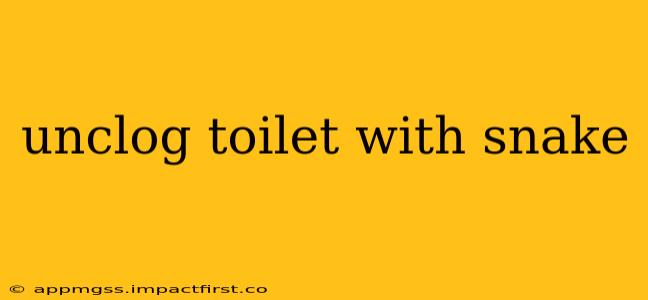A clogged toilet is a frustrating plumbing problem, but often a simple solution is within reach. A plumbing snake, also known as a drain auger, is a handy tool that can effectively clear many toilet clogs. This guide will walk you through the process, helping you tackle that blockage efficiently and effectively.
What is a Plumbing Snake (Drain Auger)?
Before we begin, let's clarify what a plumbing snake is. It's a flexible metal coil with a handle at one end and a pointed tip at the other. The flexible nature allows it to navigate the bends in your toilet drain, reaching the clog and breaking it up. They come in various lengths and thicknesses, so choose one appropriate for your needs. A shorter snake is often sufficient for toilet clogs.
How to Unclog a Toilet with a Snake: A Step-by-Step Guide
1. Gather Your Supplies:
- Plumbing snake: Choose one appropriate for toilets; shorter snakes are generally sufficient.
- Rubber gloves: Protect your hands from bacteria and grime.
- Bucket or rags: To catch any overflow or spilled water.
- Flashlight: Helpful for seeing inside the toilet bowl. (Optional)
2. Prepare the Toilet:
- Remove excess water: If the water level is high, carefully remove some using a bucket or sponge. This gives you more room to work with the snake.
3. Insert the Snake:
- Gently insert the snake: Carefully feed the snake into the toilet drain opening. Avoid forcing it, as this could damage the porcelain. Rotate the handle as you insert it to help it navigate the bends and reach the clog.
4. Locate and Break Up the Clog:
- Feel for resistance: As you feed the snake down, you'll feel resistance once you hit the clog. Continue to rotate the handle to break up the obstruction. You may hear a change in sound or feel the resistance lessen as the clog disintegrates.
5. Retrieve the Snake:
- Slowly withdraw the snake: Once you feel the resistance is gone, slowly and carefully retract the snake. Clean the snake thoroughly before storing it.
6. Flush the Toilet:
- Flush and check: Flush the toilet to check if the clog has been cleared. If the water drains smoothly, the problem is resolved. If not, you may need to repeat the process or consider alternative methods.
What if the Snake Doesn't Work?
If the snake isn't effective, the clog may be further down the drain line, or it could be a more severe blockage. In this case, you might consider:
- Trying a plunger: A powerful plunger can sometimes dislodge stubborn clogs.
- Using a toilet auger with a different design: Some toilet augers have different tip designs.
- Calling a plumber: If all else fails, contacting a professional plumber is the best course of action. They have specialized tools and expertise to handle more complex plumbing issues.
How to Prevent Future Toilet Clogs
Preventing clogs is key to avoiding future plumbing headaches. Here are some simple tips:
- Avoid flushing inappropriate items: Never flush anything other than toilet paper and human waste. This includes feminine hygiene products, cotton balls, paper towels, and "flushable" wipes (which often aren't).
- Be mindful of what you put in the toilet: Avoid dropping large amounts of solid waste or excessive tissue paper at once.
- Regular maintenance: Periodically check the toilet for any unusual build-up or slow draining.
What Causes Toilet Clogs?
Toilet clogs are frequently caused by:
- Excessive toilet paper: Using too much toilet paper can overwhelm the drainage system.
- Foreign objects: Flushing items other than toilet paper and waste can easily lead to clogs.
- Sewage buildup: Over time, sewage buildup can restrict the flow of water.
- Mineral deposits: Mineral buildup inside the pipes can narrow the passage and impede drainage.
By following these steps and preventative measures, you can effectively unclog your toilet using a plumbing snake and avoid future plumbing problems. Remember to always prioritize safety and, when in doubt, call a professional plumber.
